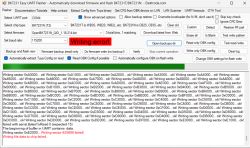I can't seem to find an answer to a topic that is strange to me, nor do I actually have any experience with these modules. To start with, I uploaded the official soft and the module presents itself as follows:
.
And now my problems:
1. AT+CWLAP basically responds all the time with just OK, less often ERROR, and in general it's a holiday when it shows what it's chasing in the air. The correct list of networks appears basically all the time, as long as the module has connected to one of them.
2. it won't connect to the home router for anything. It appears
.
From what I've read CWJAP:4 can mean anything and nothing. Supposedly it is possible to turn on in the ESP code and peek at, among other things, this cause but it is too much for me at the moment. Which way to go to look for solutions to the problem?
3. even when CWLAP returns nothing, I have been able to connect to the phone, e.g.
.
4 I write to it from a terminal and occasionally get it wrong. In extreme cases I have to reset it because it stops contacting. These modules can be so easily "tired"?
Code: C / C++
And now my problems:
1. AT+CWLAP basically responds all the time with just OK, less often ERROR, and in general it's a holiday when it shows what it's chasing in the air. The correct list of networks appears basically all the time, as long as the module has connected to one of them.
2. it won't connect to the home router for anything. It appears
Code: C / C++
From what I've read CWJAP:4 can mean anything and nothing. Supposedly it is possible to turn on in the ESP code and peek at, among other things, this cause but it is too much for me at the moment. Which way to go to look for solutions to the problem?
3. even when CWLAP returns nothing, I have been able to connect to the phone, e.g.
Code: C / C++
4 I write to it from a terminal and occasionally get it wrong. In extreme cases I have to reset it because it stops contacting. These modules can be so easily "tired"?






